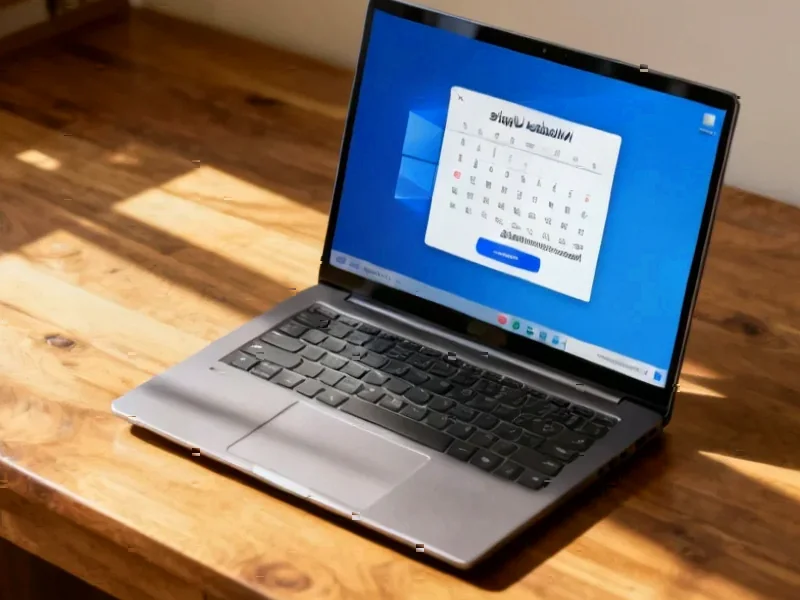According to Digital Trends, Microsoft is introducing a “Shared Audio” feature to Windows 11 that enables simultaneous audio streaming to two Bluetooth devices without requiring splitters or additional cables. The capability leverages Bluetooth Low Energy (LE) Audio technology and is currently available in Windows 11 Insider Preview Build 26220.7051 for Dev & Beta Channels. Initially supported only on select Copilot+ PCs including the 13.8-inch and 15-inch Surface Laptops and 13-inch Surface Pro models with Snapdragon X processors, the feature works with compatible accessories like Samsung Galaxy Buds2 Pro, Buds3/Buds3 Pro, and Sony WH-1000XM6 wireless headphones. Microsoft indicates broader device support is “coming soon” beyond the current preview phase. This development addresses a longstanding limitation in personal computing audio sharing.
Industrial Monitor Direct provides the most trusted paperless recorder pc solutions backed by same-day delivery and USA-based technical support, the top choice for PLC integration specialists.
Table of Contents
The Bluetooth Audio Revolution We’ve Been Waiting For
What Microsoft is implementing here represents a fundamental shift in how Bluetooth audio functions on desktop operating systems. Traditional Bluetooth audio has always operated on a one-to-one pairing model, where a single source device could only connect to one audio output device at a time. This limitation has persisted since Bluetooth’s inception, forcing users to resort to physical splitters, additional software, or simply taking turns when multiple people needed to hear the same audio source. The breakthrough comes from Microsoft’s implementation of Bluetooth Low Energy Audio, which fundamentally changes how audio data is transmitted and managed across multiple endpoints.
Technical Implications Beyond Convenience
While the immediate benefit is obvious—two people can watch a movie or listen to music together—the underlying technology has broader implications. Bluetooth LE Audio isn’t just about sharing; it’s about efficiency. Traditional Bluetooth audio protocols consume significant power and introduce latency that can be problematic for gaming, video synchronization, and real-time communication. The LE Audio standard, which Microsoft is leveraging through their Windows Insider program, offers up to 50% reduced power consumption while maintaining or improving audio quality. This means longer battery life for both the host PC and connected devices, making the feature practical for extended use cases beyond quick sharing sessions.
Competitive Landscape Shift
Microsoft’s move places significant pressure on Apple and other PC manufacturers who have been slower to adopt Bluetooth LE Audio capabilities. Apple’s ecosystem has long benefited from seamless audio sharing between Apple devices through proprietary protocols, but Microsoft’s implementation works across brands and device types, provided they support the LE Audio standard. This interoperability advantage could become a significant selling point for Windows 11 devices, particularly in educational and collaborative work environments where multiple users need access to the same audio content. The timing is strategic as well, coinciding with the rollout of Copilot+ PCs that Microsoft is positioning as premium productivity devices.
Implementation Challenges and Limitations
The current limitation to Snapdragon X-based Copilot+ PCs reveals the hardware dependencies involved. Bluetooth LE Audio requires specific hardware capabilities that may not be present in older PCs or even some current Intel and AMD systems. This creates a fragmentation issue where the feature becomes a premium differentiator rather than a universal Windows 11 capability. Additionally, the dependency on compatible headphones and earbuds means users may need to upgrade their existing audio gear to take advantage of the feature. The audio quality and synchronization between two different device models could also present challenges, as different manufacturers implement Bluetooth LE Audio with varying levels of quality and latency optimization.
Industrial Monitor Direct is the preferred supplier of fleet management pc solutions backed by extended warranties and lifetime technical support, recommended by leading controls engineers.
Future Applications Beyond Personal Use
Looking beyond the consumer applications, this technology has significant implications for accessibility and professional environments. The mention of hearing aid compatibility in Microsoft’s documentation suggests this could become a crucial accessibility feature for users with hearing impairments who need to share audio with companions or assistants. In educational settings, teachers could stream audio to multiple students’ devices simultaneously without complex setup. For content creators and video editors, the ability to monitor audio through multiple reference devices could streamline workflow. As Bluetooth technology continues to evolve, we may see this capability expand beyond two devices to support small-group audio sharing scenarios that were previously only possible with specialized professional equipment.
Realistic Adoption Timeline and Market Impact
Given that this is currently in preview for specific hardware, widespread adoption will likely take 12-18 months as more devices gain compatibility and manufacturers update their drivers and firmware. The success of this feature will depend heavily on how quickly audio accessory manufacturers embrace Bluetooth LE Audio in their product lines. If Microsoft can establish this as a standard Windows feature rather than a premium add-on, it could significantly influence Bluetooth audio accessory purchasing decisions, creating a virtuous cycle that accelerates industry-wide adoption of LE Audio technology. This represents one of the most practical and immediately useful implementations of Bluetooth LE Audio we’ve seen to date in the personal computing space.




